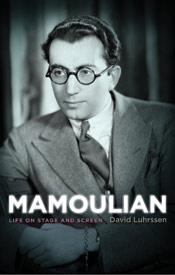(The University Press of Kentucky, 208 pages, $40)
By David Luhrssen
 His name does not conjure the almost automatic word association that comes with discussing film’s most legendary directors: Hitchcock, his suspense; Lubitsch, his touch; and Ford, his Westerns. But Rouben Mamoulian, an imaginative innovator and one of the original founding fathers of the Directors Guild of America, has remained something of a mystery. Until now.
His name does not conjure the almost automatic word association that comes with discussing film’s most legendary directors: Hitchcock, his suspense; Lubitsch, his touch; and Ford, his Westerns. But Rouben Mamoulian, an imaginative innovator and one of the original founding fathers of the Directors Guild of America, has remained something of a mystery. Until now.
David Luhrssen’s meticulously researched biography Mamoulian: Life on Stage and Screen is the first major work on this often-neglected director. Mamoulian possessed a fierce confidence in his vision, but because a single genre or style did not dominate his work, his legacy seems to have been overlooked by auterists. His filmography remains frustratingly paradoxical. But Luhrssen makes a convincing argument that Mamoulian was the undisputed author of his films in every way.
As a successful young stage director in the late ’20s, Mamoulian was recruited by Hollywood where, accustomed to the authority afforded him on Broadway, he was at odds with the studio system from day one. Born in Russia to cultured Armenian parents, and having witnessed the Bolshevik Revolution firsthand and experienced poverty in London, the tantrums of studio moguls held little threat; he was game for the fight.
Perhaps his most noble battle was for the creative freedom of his fellow directors. When he was approached by King Vidor to help unionize directors in 1936, Mamoulian became an energetic campaigner, a wining and dining wheeler-dealer. He had a lifelong allegiance to his Guild as well as an unwavering belief in the integrity of artistic vision. Luhrssen vividly recreates Mamoulian’s heated exchanges with studio heads, as well as the director’s refusal to compromise his principles when he was targeted during the Hollywood blacklist era of the ’50s.
But the book’s most revelatory moments are those that focus on Mamoulian’s creative process. His work ethic and directorial approach have rarely enjoyed such careful examination. Indeed, Luhrssen puts the biographical details in place largely to provide the context for the director’s craft. Some of Mamoulian’s best known films—Love Me Tonight (1932) and Queen Christina (1933)—demonstrate his flair for stylized rhythm, harmony of form and light, and the fundamental art of motion and sound. It was a gift that, in the static world of early talking pictures, brought grace and fluidity to his films.
He also viewed technology as a creative tool, not a toy, allowing for such inventions as overlapping dialogue, and camera and microphone movement. Mamoulian was also responsible for directing Hollywood’s first Technicolor feature, Becky Sharp (1935), approaching color motifs with painterly psychology.
Sparsely illustrated for a work about such a highly visual filmmaker, the imagery is found instead within Luhrssen’s fluid, uncomplicated prose. A penetrating picture emerges of this enigmatic master showman and his exotic, Eurasian aesthetic coupled with cultured humanism that infused his work on Broadway and in Hollywood. This is an elegant, forthright study befitting a man who so openly wore his heart on his stylishly cuff linked sleeves.
Review written by Carley Johnson.